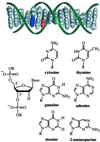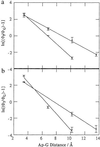Effects of strand and directional asymmetry on base-base coupling and charge transfer in double-helical DNA
- PMID: 12486238
- PMCID: PMC139180
- DOI: 10.1073/pnas.012669599
Effects of strand and directional asymmetry on base-base coupling and charge transfer in double-helical DNA
Abstract
Mechanistic models of charge transfer (CT) in macromolecules often focus on CT energetics and distance as the chief parameters governing CT rates and efficiencies. However, in DNA, features unique to the DNA molecule, in particular, the structure and dynamics of the DNA base stack, also have a dramatic impact on CT. Here we probe the influence of subtle structural variations on base-base CT within a DNA duplex by examining photoinduced quenching of 2-aminopurine (Ap) as a result of hole transfer (HT) to guanine (G). Photoexcited Ap is used as a dual reporter of variations in base stacking and CT efficiency. Significantly, the unique features of DNA, including the strandedness and directional asymmetry of the double helix, play a defining role in CT efficiency. For an (AT)n bridge, the orientation of the base pairs is critical; the yield of intrastrand HT is markedly higher through (A)n compared with (T)n bridges, whereas HT via intrastrand pathways is more efficient than through interstrand pathways. Remarkably, for reactions through the same DNA bridge, over the same distance, and with the same driving force, HT from photoexcited Ap to G in the 5' to 3' direction is more efficient and less dependent on distance than HT from 3' to 5'. We attribute these differences in HT efficiency to variations in base-base coupling within the DNA assemblies. Thus base-base coupling is a critical parameter in DNA CT and strongly depends on subtle structural nuances of duplex DNA.
Figures





Similar articles
-
DNA charge transport: conformationally gated hopping through stacked domains.J Am Chem Soc. 2004 Sep 22;126(37):11471-83. doi: 10.1021/ja048956n. J Am Chem Soc. 2004. PMID: 15366893
-
2-Aminopurine: a probe of structural dynamics and charge transfer in DNA and DNA:RNA hybrids.J Am Chem Soc. 2002 Nov 6;124(44):13053-66. doi: 10.1021/ja0208198. J Am Chem Soc. 2002. PMID: 12405832
-
Direct chemical evidence for charge transfer between photoexcited 2-aminopurine and guanine in duplex DNA.J Am Chem Soc. 2004 Feb 11;126(5):1316-7. doi: 10.1021/ja037802p. J Am Chem Soc. 2004. PMID: 14759170
-
Long-range DNA charge transport.J Org Chem. 2003 Aug 22;68(17):6475-83. doi: 10.1021/jo030095y. J Org Chem. 2003. PMID: 12919006 Review.
-
Excited states in DNA strands investigated by ultrafast laser spectroscopy.Top Curr Chem. 2015;356:39-87. doi: 10.1007/128_2014_570. Top Curr Chem. 2015. PMID: 25326834 Review.
Cited by
-
DNA Damage Emanating From a Neutral Purine Radical Reveals the Sequence Dependent Convergence of the Direct and Indirect Effects of γ-Radiolysis.J Am Chem Soc. 2017 Dec 13;139(49):17751-17754. doi: 10.1021/jacs.7b10942. Epub 2017 Nov 30. J Am Chem Soc. 2017. PMID: 29190086 Free PMC article.
-
Metal Complexes for DNA-Mediated Charge Transport.Coord Chem Rev. 2011 Apr 1;255(7-8):619-634. doi: 10.1016/j.ccr.2010.09.002. Coord Chem Rev. 2011. PMID: 21643528 Free PMC article.
-
Positional Dependence of DNA Hole Transfer Efficiency in Nucleosome Core Particles.J Am Chem Soc. 2019 Jul 3;141(26):10154-10158. doi: 10.1021/jacs.9b03686. Epub 2019 Jun 25. J Am Chem Soc. 2019. PMID: 31244168 Free PMC article.
-
Rationalizing the environment-dependent photophysical behavior of a DNA luminescent probe by classical and non-adiabatic molecular dynamics simulations.Photochem Photobiol Sci. 2023 Sep;22(9):2081-2092. doi: 10.1007/s43630-023-00431-3. Epub 2023 May 11. Photochem Photobiol Sci. 2023. PMID: 37166569
-
Single-step charge transport through DNA over long distances.J Am Chem Soc. 2011 Mar 23;133(11):3863-8. doi: 10.1021/ja107033v. Epub 2011 Feb 24. J Am Chem Soc. 2011. PMID: 21348520 Free PMC article.
References
-
- Dekker C. & Ratner, M. A. (2001) Phys. World 14, 29-33.
-
- Boon E. M. & Barton, J. K. (2002) Curr. Opin. Struct. Biol. 12, 320-329. - PubMed
-
- Giese B. (2002) Annu. Rev. Biochem. 71, 51-70. - PubMed
-
- Schuster G. B. (2000) Acc. Chem. Res. 33, 253-260. - PubMed
-
- Lewis F. D., Letsinger, R. L. & Wasielewski, M. R. (2001) Acc. Chem. Res. 34, 159-170. - PubMed
Publication types
MeSH terms
Substances
Grants and funding
LinkOut - more resources
Full Text Sources

